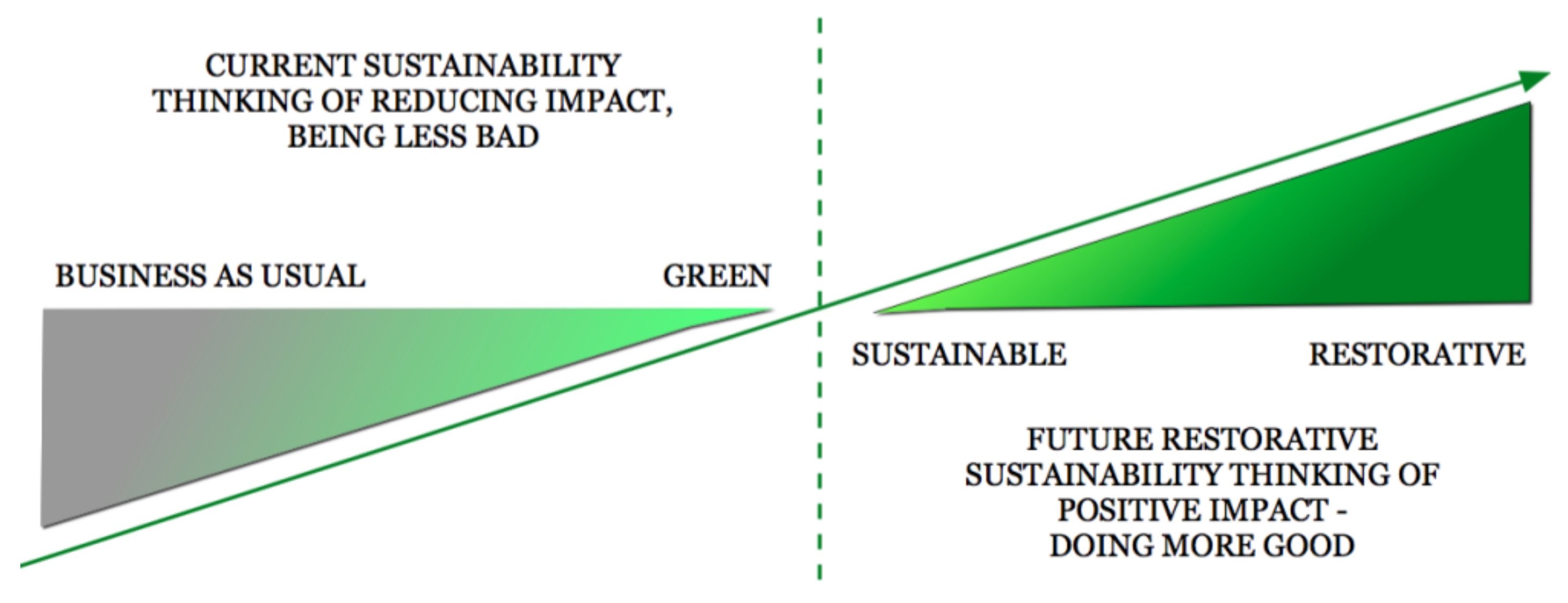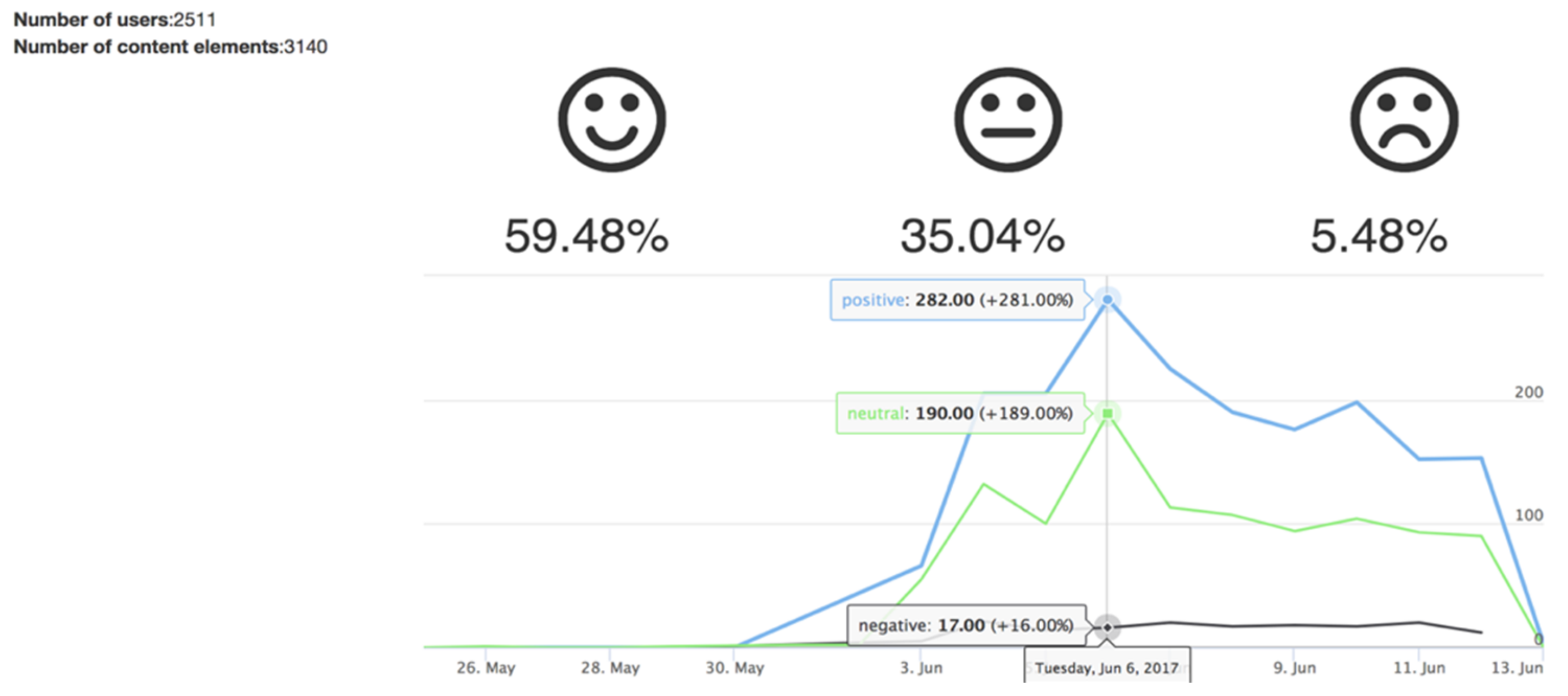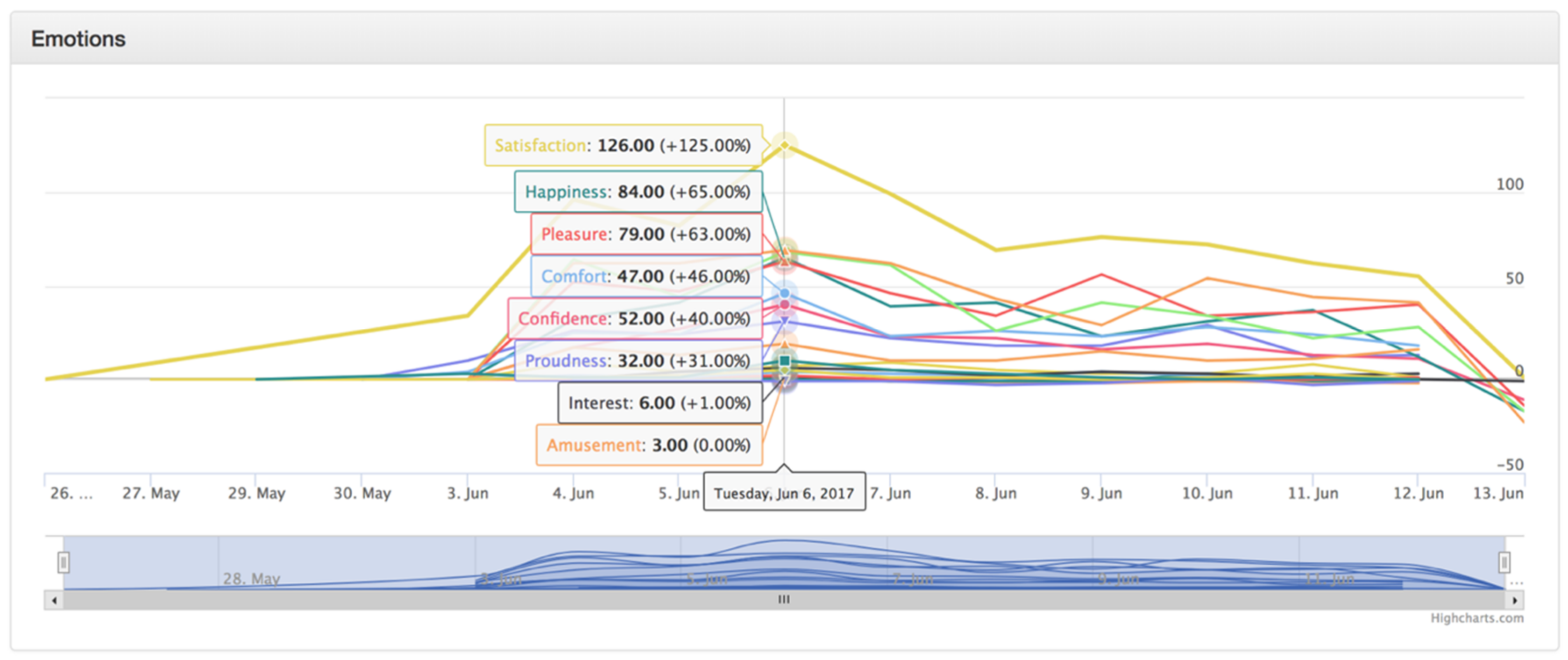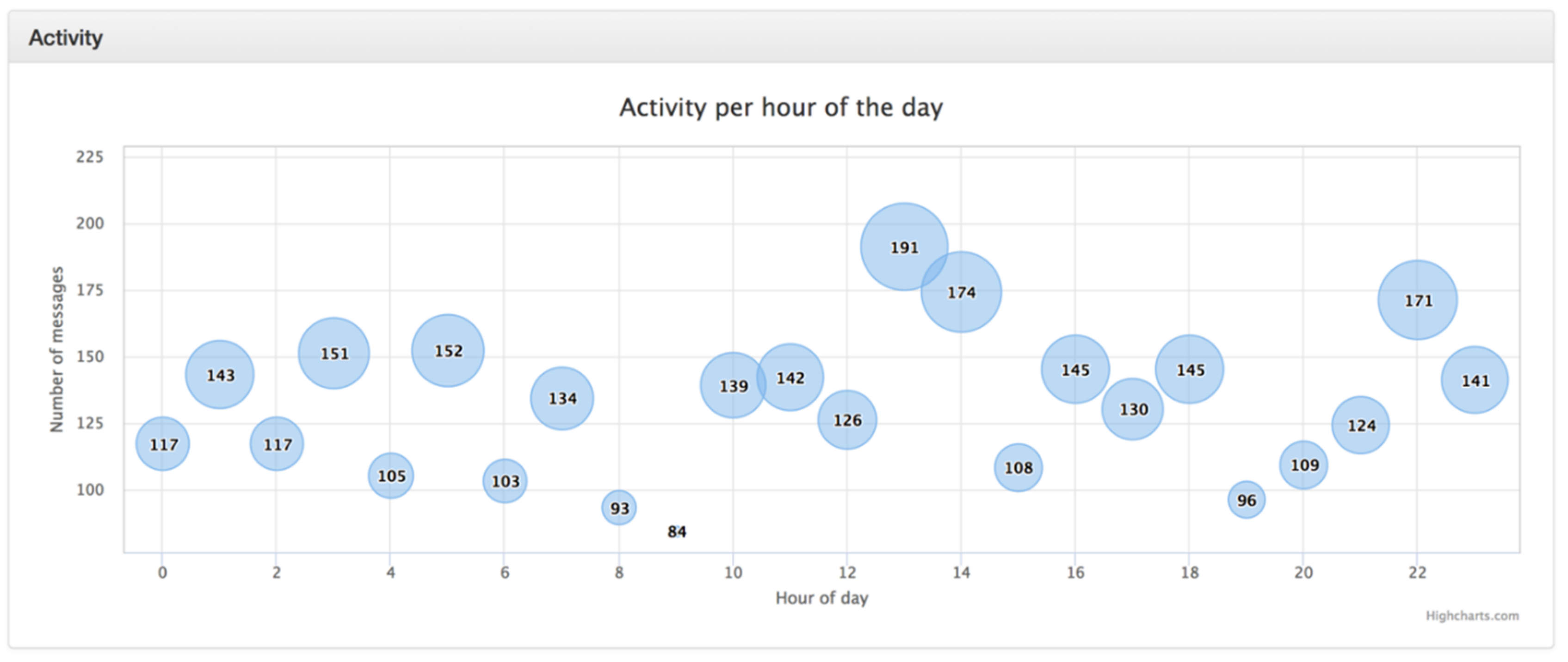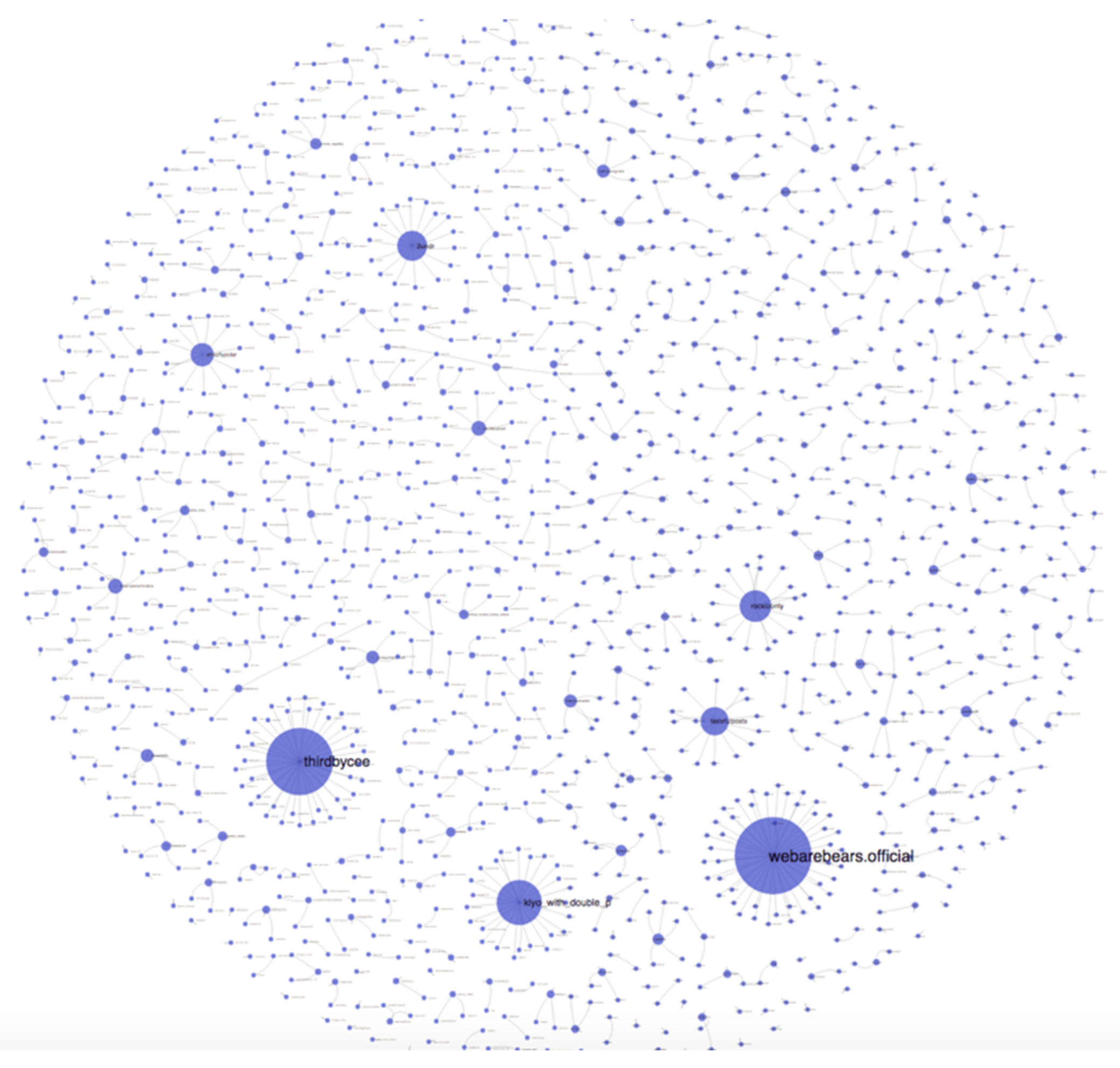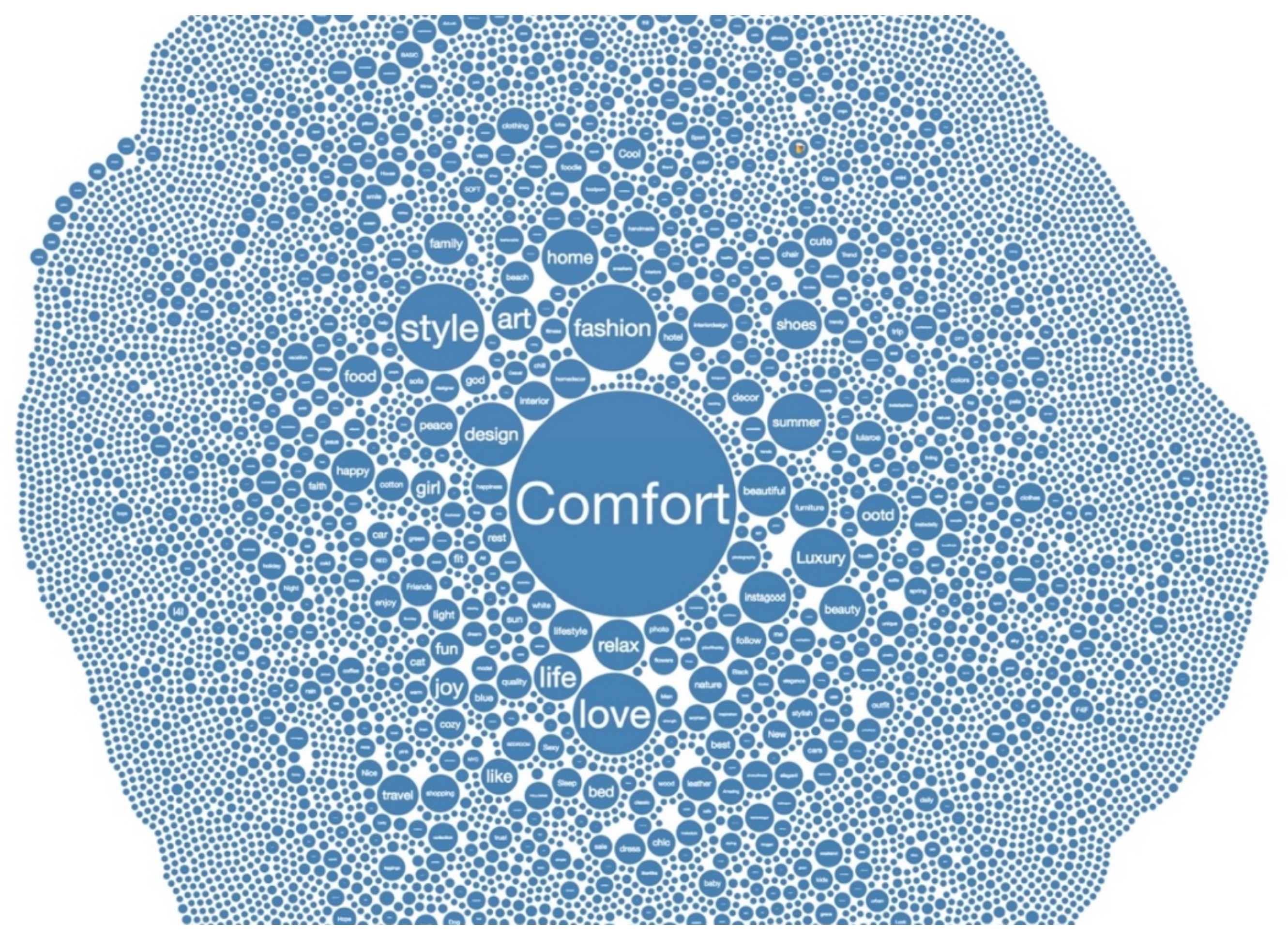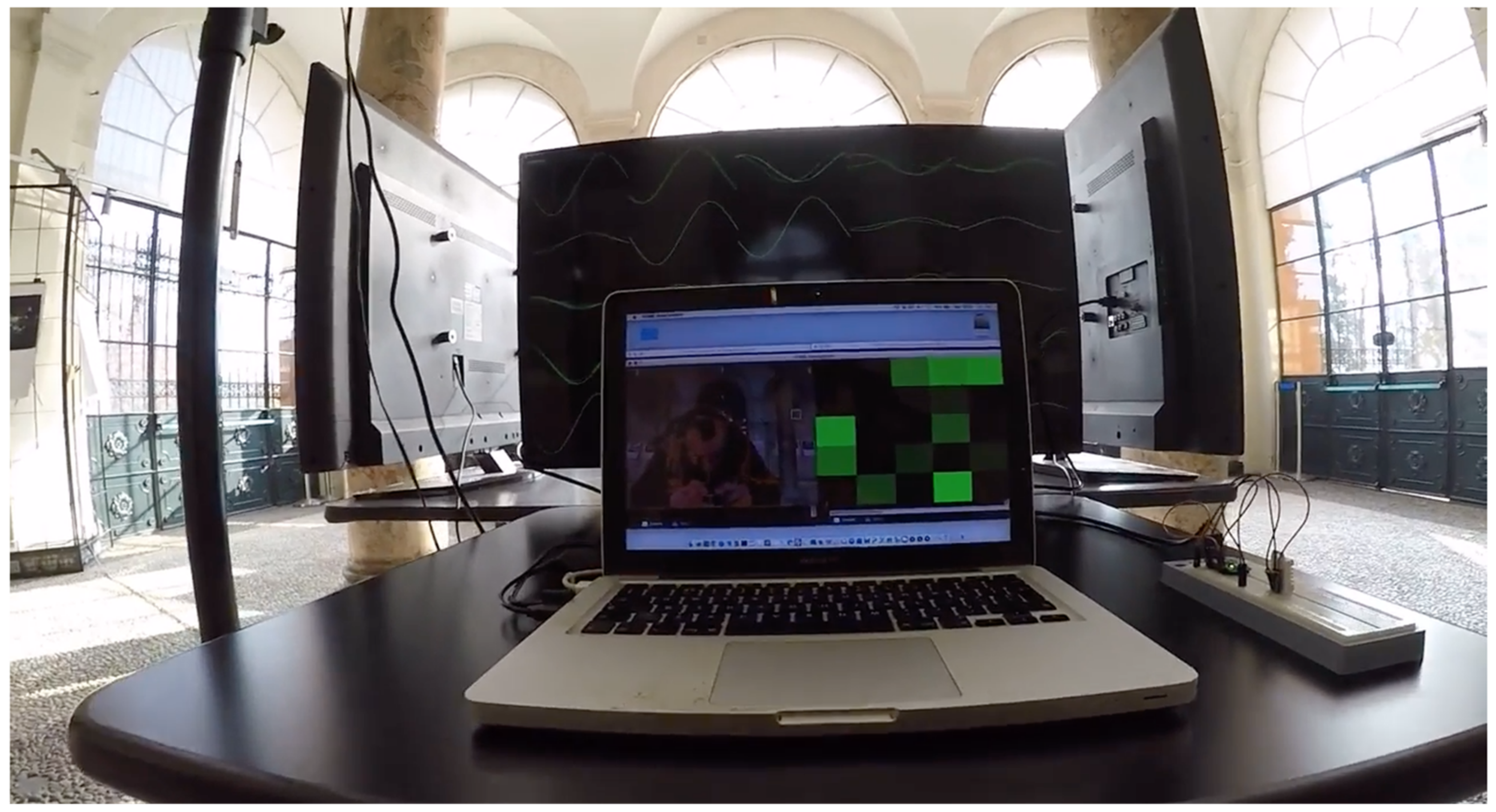1. Introduction
Sustainability has been defined, for the last 30 years, by the 1987 Our Common Future, ‘Brundtland’ definition that states for a sustainable future we should not do anything today that compromises tomorrow’s generation. However, it is now evident from the increasing threat and impact of climate change and the dramatic loss of biodiversity that we continue to severely impact future generations. In particular, the built environment, through health issues that arise from our buildings, their construction, component production, and in occupation, remains a highly significant contributor to climate change.
Smart buildings are a significant evolving trend within wider technological development, often welcomed as the panacea for the climate change challenge. But even via smarter ways, the built environment and its operation use large amounts of resources.
Looking at the overarching context, we are in transition from the concept of sustainability as the duty to limit the damages caused, to a vision of regenerative sustainability, that is the need to restore social and ecological systems to a healthy state and progressively toward the regenerative sustainability, which enables the social and ecological system to evolve (please refer to [
1] and Storify). In this paradigm, sentient buildings are those that can share memories and stories from the past and send messages to current and future inhabitants. As noted by social network analysis, this is a crucial aspect of the stories humans share, not just related to thermal comfort, but to a broader feeling and a sense of wellness and wellbeing.
An alternative ‘regenerative sustainability’ approach emphasises low-impact design with a small ecological footprint, organic design using natural materials and ecological engineering, nurturing the spirit of the place and recalling vernacular design as a healthy relationship to place [
2], as the basis for the equilibrium of a building’s thermal features and ultimately its sustainability performance.
Here, the concept of biophilic design is introduced. Buildings that have biophilic aspects improve comfort levels and reduce related energy costs, since we need less heating, cooling and mechanical systems in buildings in terms of air quality, light, and materials used [
3], further we need to ‘listen’ to the cultural human ecosystem living within them [
4]. A social network semantic analysis of the word ‘comfort’ is also undertaken.
Nevertheless, only a few studies exist in considering these ‘human’ domains when evaluating the sustainability profiles of buildings and cities [
5,
6]. In today’s anthroprocene era, climate change is a proper responsibility of urban living models [
7,
8], yet human experience and behaviours are still mostly unaccounted for by designers, informatics, engineers, and policymakers [
9,
10].
This creates a severe gap in current research about strategies for mitigating built environment impacts, data collection, and the role of particular design elements in comfort perceptions. The potential for using these environmental associations as a performance feature to be measured, evaluated, and transferred as parametric elements in Regenerative Environmental Design (RED) is often under-evaluated [
11]. The regenerative design concept is at the core of this spectrum as it does not exclude the possibilities provided through technology, shifting from a narrow focus on building energy performance, mitigation strategies, and minimisation of environmental impacts, to a broader framework that enriches places, people, ecology, culture, and climate [
12,
13]. Therefore, the question of how social networks, advanced materials, and energy optimisation systems can support the change of paradigms remains a valid one to address.
In this paper, we aim to explore the opportunities provided by current ICT tools in supporting human-centric inter-disciplinary research and the regenerative sustainability paradigm shift. Our enquiry seeks to understand which kind of technologies (social network analysis, natural interactions, and artificial intelligence) could be used to create systems that establish new relationships between buildings, mechanical systems, and inhabitants and that in turn support the research about human-centric design tools.
The aim of this article is as follows:
Review the current literature about smart building, sentient buildings, and restorative/regenerative sustainability;
Highlight, in this review, current solutions in human–building interaction systems and regenerative building design;
Analyse the semantic realm of the word ‘comfort’ to explore the potential of a parallel social network analysis of the interconnection between user perceptions and regenerative design;
Build a prototype ICT architecture for observing and gathering preliminary information relating to human behaviours, their relationships, and their patterns of building use, including innovative artificial intelligence (AI) methods and technologies;
Expose to a multidisciplinary audience a prototype ICT architecture of the project, described as an alternative response to the gaps envisaged in the literature review.
The ideas in these sections are used to observe the reactions and feed the discussion that took place after the Human Observation Meta-Environment (HOME) ICT architecture prototype was developed and tested for two days in a case study room at Valentino Castle, Politecnico di Torino. People from different disciplinary backgrounds interacted with the HOME prototype through a multidisciplinary workshop. Results are discussed in light of a regenerative approach, enabling discussion of the potential technological, psychological, cognitive, cultural, and aesthetical impacts of enabling new types of human–building interactions in regenerative design.
Conclusions relate the experiment’s outcomes to literature on regenerative design research, enriching the discussion of how new ICT tools can assist in determining influencing factors in regenerative design practices.
2. Background
2.1. Smart Buildings and Their Users
Smart buildings are a significant evolving trend of wider technological development, often cited within Industry 4.0 convergence of digital technologies. Despite numerous examples of this ‘labelling’ phenomenon, we know surprisingly little about smart buildings, often due to a lack of definitional precision, an underlying self-congratulatory tendency, and mainstream ICT’s move into the market of smart appliances [
14,
15,
16].
User-focused research on smart homes is increasing, dominated by engineering, technical sciences and design, as is attention from health-care and social scientists ranging from ethnographers and psychiatrists to economists and applied energy researchers. Eminent sociologists [
17,
18] note that a preoccupation with a ‘classic’ paradigm of science and economics may have created a ‘blind spot’ in ‘conventional techno-economic thinking’ that masks the ‘human factors’ of energy technologies and application in the built environment [
19].
When the success of smart buildings depends on a collaboration between (1) the visions of technology experts for enhanced system functionality and energy management and (2) the needs and demands of users, the latter is often discharged. There is a growing recognition for the need to develop a better understanding of building users and how they might use buildings [
20,
21]—in particular, user–technology interactions, acceptability, and usability.
However, as highlighted by Wilson [
22], these themes have not typically been entry points for thinking about a regenerative design shift. Rather, they have emerged as a concern of a technological vision that is struggling to gain user acceptance. The result is that existing visions of smart homes are perceived as failing to meet user needs and sustainability performances, in an era where aiming for more sustainable buildings is critical to achieving a future that is ‘socially just, ecologically regenerative, culturally rich and economically viable’ [
11].
A systematic review of published literature on smart homes and their users [
22] discloses an organising framework and the scope of research themes and lines for positioning and inter-relating research. Three broad views are evident: a functional view, an instrumental view, and a socio-technical view. The functional view sees buildings as a way of better managing the demands of daily living through technology.
The instrumental view emphasises smart homes’ potential for managing and reducing energy demand in households as part of a wider transition to a low-carbon future. The socio-technical view sees the smart home as the next wave of development in the ongoing electrification and digitalisation of everyday life [
22]. A notable shortcoming in this framework is that a more representative view of smart homes responses amongst public and expert communities should be developed, in order to investigate how different social or psychological factors (e.g., income, gender, values, and experience) may shape responses to smart technologies and to the sustainability challenge [
23].
Indeed, the domains of data, information, and knowledge about buildings and how people inhabit them are systematically excluded from a built-environment stakeholder’s perspective [
24,
25]. For example, emotions, affordances, wellbeing [
26], or the appreciation of natural views, artworks, or natural materials, as found in the concept of regenerative design, are excluded in the data appraisal of designers or engineers. On another level, the authors of [
27] stated that ‘our thermal environment is as rich in cultural associations as our visual, acoustic, olfactory, and tactile environments’. For building design, this association should be studied and developed.
2.2. Sentient Buildings
Smart buildings have by definition multiple systems for capturing and monitoring data, which is why we now talk about sentient buildings. A sentient building is one that ‘possesses a sensor-supported, dynamic, and self-updating internal representation of its own components, systems, and processes. It can use this representation, amongst other things, toward the full or partial self-regulatory determination of its indoor-environmental status’ [
28].
Systems for collecting data related to human presence, environmental conditions, energy usage and efficiency, and service quality levels [
29,
30] are often not integrated with each another [
31] and are seldom harmonised [
32].
Furthermore, these data capture processes are one-way. Building inhabitants are rarely aware of the consistency and quality of their energy consumption, the services in use, and the related environmental impacts [
33]. When they are, they are rarely informed about meaningful benchmarks, thresholds, or viable alternatives to change, for example, temperature and lighting levels, nor are they interested in achieving significant improvements without sacrificing comfort, security, or wellbeing [
34].
Negotiation between different needs and desires of people living, working or playing within the buildings and the quantitative parameters are often set up in advance and often left unmanaged. One of the critical issues here is that public building inhabitant’s feelings are not heard, thus left unaddressed. This is critical if we take into consideration that energy and environmental impacts are caused by people and not by buildings.
Human-centric design theories start from a study of user perceptions, beliefs, and behaviours in relation to energy consumption, comfort, and ultimately the design of buildings and spaces [
35]. For example, individuals with a ‘pro-environmental’ approach tend to be more ‘forgiving’ in accepting a significant degree of discomfort in green buildings [
36]. More culturally relaxing or top-down-induced clothing norms change occupant expectations of more/less control over indoor environments, and these are demonstrated to increase a negotiation between thermal comfort, energy use, and human-centric design [
37].
There have been experimentations around building–human interfaces that can lead to the personalisation of space (for example through voice control) and to the implementation of buildings that learn from experience [
38,
39,
40], establishing an integrated building–human knowledge generation system like the ‘ecobee4 Smart Thermostat’ or the ‘Nest Learning Thermostat’. Through these current scenarios, we are now in an era of sentient buildings and cities described by [
41,
42,
43], and many question the impacts of data, information, and ubiquitous intelligence when they pervade completely and pervasively, the environment we experience every day, the objects we use, the schools, homes, offices we live in, and all the means we use to inform, connect, learn, work, and enjoy ourselves alone or with others.
2.3. Regenerative Sustainability
The regenerative sustainability concept relies on a holistic ethic that includes all stakeholders in dialogue, encouraging feedback for continuous refinement and improvement. It seeks to imitate the efficiency and diversity of nature and create design solutions that are responsive, self-regulating, full of spirit, and hence able to take advantage of opportunities provided by user-inspired technological innovations.
However, not all individuals will have the same leverage or will give the same importance to controllable variables inside a building, since expectations, culture, religion, education, and experience tend to mediate our comfort perception [
44,
45].
The emergent paradigms of restorative and regenerative sustainability address the approaches vital for a sustainable future. Such paradigms have been framed recently by the authors of [
11] as in the following list:
Sustainable approaches limiting negative impact to the point at which we give back as much as we take from ecosystems;
Restorative—approaches that restore eco-, social, and economic systems to a healthy state;
Regenerative—approaches that enable eco-, social, and economic systems to flourish, resulting in co-benefits from the approaches;
The regenerative design of buildings is a purposeful and intentional design that identifies co-benefits beyond the scope of the building, at ecological, social, health, and economic levels.
Regenerative, sustainable paradigms move beyond the relationship of users with buildings and its functional systems to address the emergent and complex relationship of users as inhabitants with the building that itself is a designed holistic eco-system.
Indeed, we no longer have the luxury of simply being ‘less bad’ but must now focus on doing more good, including a salutogenic approach to people’s health, but we now have no non-radical approaches available to us [
46]. (
Figure 1). Emergent frameworks and standards that acknowledge a regenerative approach include the Sustainable Development Goals, the Living Building Challenge, the WELL Building Standard, and One Plant Living. The Living Building Challenge [
47], the world’s toughest and most robust building standard, in addition to its net-positive imperatives of energy, water, air quality, and materials, places significant importance on place, health, happiness, equity, and beauty.
Human-centric aspects also receive high priority with the WELL Building Standard (e.g., mind, nourishment, and fitness) and One Planet Living (e.g., health, happiness, equity, and culture). A notable feature of the Living Building Challenge is the accreditation requirement for proving design intent over a 12-month continuous period, post-construction. This has the effect of making building users and facility management as crucial to the success of the project for certification as the design and construction phases.
3. Aims and Methods
Understanding, educating, and influencing inhabitant behaviour, through smart monitoring, social media, and AI will become an essential element of building sustainability. Given the gaps envisaged in the literature about human–building interactions for fostering the regenerative sustainability shift, in this paper we set out to explore the opportunities provided by current ICT tools in supporting human-centric inter-disciplinary research, and the claimed paradigm change. Our enquiry seeks to understand which technologies (social network analysis, natural interactions, and artificial intelligence) can be used to create systems that establish new relationships between buildings, mechanical systems, and inhabitants, in turn supporting the research about human-centric design tools.
This is why the structure of our aims and related methods follows these steps:
Review the current literature about smart building, sentient buildings, and restorative/regenerative sustainability to highlight current solutions in human–building interaction systems and regenerative building design (
Section 2 and its subparagraphs);
Analyse the semantic realm of the word ‘comfort’ (
Section 4) to explore the potential of a parallel social network analysis of the interconnection between user perceptions and regenerative design;
Build a prototype ICT architecture described as an alternative response to the gaps envisaged in the literature review. This is for observing and gathering preliminary information relating to human behaviours, their relationships, and their patterns of building use, including innovative artificial intelligence methods and technologies, as in the aim of the HOME project (
Section 5);
Expose a prototype ICT architecture to a multidisciplinary workshop to discuss the results in light of a regenerative approach, thus enabling a discussion on the potential technological, psychological, cognitive, cultural, and aesthetical impacts of new types of human–building interactions in a regenerative design (
Section 6,
Section 7 and
Section 8).
4. The Social Network Analysis on ‘Comfort’
Focusing on comfort we are looking to better understand the factors influencing the sustainable performance of a building. The active involvement of users in human-centric design and the adoption of more sustainable lifestyles gives new meaning to concepts about the energy transition, the role of society aside, and the role of technology [
48]. That is why the first stages of the HOME project explore perceptions in social networks in relation to human–energy fields. Through the use of an open-source platform called Human Ecosystems (
http://www.human-ecosystems.com/), a large-scale mapping analysis on Twitter and Instagram was performed (see acknowledgments), filtering for the hashtag ‘comfort’.
The geographical scope was restricted to the city of Turin, where the prototype and the whole HOME project was tested. In such data-driven studies, with an unknown dataset, the first observations aim at possible structures and models to identify trends and significant variables in a new semantic field. Data visualisation, linked to clustering techniques, can be exploited for confirmative analyses to test initial hypotheses.
The word ‘comfort’ in Twitter and Instagram posts was monitored for two weeks in June 2017. The Human Ecosystems software allows the filter of public posts and tweets from a substantial set of users from social networks [
49] and stores them into a MySQL database. The stored information contains relationships between users, as tags and retweets, and about whole posts. A few additional parameters used after the prototype test and that are supported by the Human Ecosystem platform will be demographics, the type of accounts on social media (individual, organisation, both), gender, and other features using the works of contemporary data scientists [
50,
51,
52].
The number of users talking about comfort in the city of Turin during the two weeks from the 30 May to 13 June 2017 were 2511, naming 3140 elements associated with the word ‘comfort’. The exploration is still ongoing on the open source platform to extend the observation period during winter months. Overall, the feelings connected to this word were positive 59.58% of the time, neutral 35.04% of the time, and negative 5.48% of the time. The status trend of the word ‘comfort’ reached a peak on Tuesday, June 6 (
Figure 2).
This peak was reflected in the emotions curve (
Figure 3), where on the 6th of June satisfaction was registered in the majority of users speaking about comfort (126), followed by happiness (84), pleasure (79), comfort itself (47), confidence (52), pride (32), interest (6), and amusement (3). The activity registered along the 24 h period had a peak between Hours 12 and 14 (191 message on average), high numbers at night-time (at 22,171 average messages; from 1 a.m. to 5 a.m., 145 messages), and low message rates during early morning times (around 90 from 8 a.m. to 9 a.m.) and between Hours 19 and 20 (100 messages on average) (
Figure 4).
The relation plot (
Figure 5) shows that people talking about comfort are not connected to one another, except for a few nodes that were talking about fashion brands, which influenced some surrounding nodes.
The word-cloud (
Figure 6) of the most co-cited words with ‘comfort’ showed a prevalence of the following concepts: style, fashion, love, life, relax, home, art, joy, design, summer, shoes, food, happy, girl, beautiful, instagood, family, light, travel, bed, nature, ootd, cute, décor, peace, cotton, cozy, friends, cool, cat, and so forth. Much of these relate to the realm of regenerative design (design materials, objects, natural styles, etc.), thus encouraging further research about specific features and most active users. In fact, once people connected to a precise research field are identified, the data analysist can, as a digital anthropologist, explore more deeply the virtual behaviour of those people in a given community and leverage their knowledge to obtain more focused results.
5. The HOME Project
This scenario gives the stimulus for the following research question: which technologies (social network analysis, natural interactions, and artificial intelligence) can be used to create systems that establish new relationships between buildings, mechanical systems, and inhabitants, supporting the research about human-centric design tools?
This paper attempts to address this question via the setting of the Human Observation Meta-Environment (HOME) project (see acknowledgments for further info), where a preliminary ICT architecture was built for observing and gathering information about new possible ways of human relationships with the buildings they live in. This includes technologies related to the domain of artificial intelligence—such as Natural Language Analysis, Computer Vision, Machine Learning, and Deep Learning. In the preliminary phase of the HOME project, a prototype of the ICT architecture is installed for three months in two case study rooms at Politecnico di Torino
The prototype, known as ‘Smart Agent’ (SA), is at the base of the HOME workshop that exposed the ICT architecture to a broad multidisciplinary audience made up of social science and humanities (SSH) plus science, technology, engineers, and mathematics (STEM) researchers.
The SA is included in the HOME project as part of an architectural concept for integrating sensing infrastructure in buildings into a coherent information system. A series of prototype actions are tested through a workshop to validate the concepts and to correct tools and methods before implementing and deploying a full-scale specimen of the system.
The setting of the prototype has been preceded by a study of the ‘comfort’ concept in the social networks (Instagram and Twitter) to test how these media can harvest and listen to people thoughts and to create a lexicon for regenerative design inputs.
Some technologies related to the domain of artificial intelligence have undergone the first phase of the HOME project through the SA, a sentient digital entity capable of establishing relationships with the inhabitants of the building. The SA was put for two days in a stately room at the Castello del Valentino, a UNESCO heritage site where the faculty of Architecture of Politecnico di Torino is located, and exposed visitors’ naturally occurring interactions. The results of this test created an interactive relational system between the environment and its people inhabitants, establishing new negotiating dynamics between building and people
6. The Workshop
The workshop ‘On the Warm and the Cold’ established a visual, cultural, and conceptual image of the HOME project. The question posed by prototype installation to its visitors was: ‘What happens when a building becomes sentient and wants to optimise energy consumption or explore inhabitant’s comfort quests?’ The answer was designed not to be linear but to pave the way for complex reflections in the debate of regenerative design and ICT. The SA in the prototype opened up the view of itself as an object/subject able to influence the perception of the space of buildings and people living there. The installation was thus a way to open the SA’s artificial brain to public view. The ‘transparency’ of the SA functioning was meant to avoid adverse privacy and surveillance implications to communities exposed to sentient buildings.
To establish a connection with the users of the case study rooms, students and members of universities were also involved in the mounting/dismounting phase of the prototype.
Within the prototype, three screens exposed the Smart Agent’s brain functioning mechanisms (
Figure 7). The first screen showed the SA’s computer vision, overlapping camera shoots, and red contours of the things that the algorithms found interesting (the presence of people, identified by the presence of their body), with evidence of the type of information (a human density matrix in space). The second screen showed the trend of comfort quantities (temperature and humidity) and how these are stored and interpreted. A specific sound was generated when a variation of comfort trends occurred. The third screen represented the pattern recognition engine used to look for recurring curves in the collected data, to correlate people’s behaviours to the variation of comfort and energy consumption parameters.
Ultimately, a voice declared ‘poems’ on the warm and the cold as vocalisations of the activity of the neural networks using a generative linguistic engine. The SA interpretation of the correlated event is spoken aloud in the form of a phrase (e.g., ‘the temperature rises and they are gone’). Therefore, the prototype made visible and audible, ways in which the SA is interpreting the world so that an artificial intelligence became accessible, trackable, and questionable.
During the exhibit, visitors have reflected on this and criticised the technological apparatus. For example, they discussed implications regarding privacy and control. These are and will be largely mitigated by the fact that the systems do not record any sensitive data, blur faces, and simplify the density of human presence in the space. The implications in terms of transparency and understanding of artificial intelligences made visitors wonder whether the ‘naked’ SA could counteract the substantial inability of the users to understand how these algorithms work, how to intervene in the space, what could be some invasive interventions, or how to create feelings of intimacy and conviviality as well as a relationship among active (not passive) space users.
From a technological point of view, the installation was used to check the accuracy of computer vision algorithms in perceiving presence, shifts, and gestures. How the existing monitoring infrastructures in legal, administrative, and management could be used was explained to ensure people’s involvement and activation of data collection and energy-saving strategies.
The prototype in the form of an art installation;
created participation through different disciplines,
informed people about project goals and strategies,
engaged people in dealing with the possible issues highlighted by the prototype, and
tested people’s ideas of opportunities generated in the workshop, where the reactions in the presence of the SA in the building were observed, information about the need for further adjustment and for correcting interaction modes was learned, and so on.
7. The Prototype Discussed in the Workshop
The prototype of the ICT architecture of the HOME project was discussed in the interdisciplinary workshop, where STEM as well as social sciences, humanities, and arts (SSHA) researchers envisaged sensorial, visual, interactive outputs to engage inhabitants of buildings and spaces, to become aware and active about the strategies, their behaviours/interactions/relations, and the possible legal, social, psychological implications of such technologies in sentient buildings. The prototype has been presented to the public used in the first phase in a Workshop, titled ‘On the Warm and the Cold’. More than 100 visitors participated in an open exhibit of the SA.
The hardware and software used, coupled with the presence of an artificial intelligence able to perform Voice Synthesis and Deep Learning from previous events, responds to the gap envisaged in the previous paragraphs since it
Ascertains whether it is possible through communication, relationship and interaction, to achieve a better balance of human–building interaction. The assumption is that one can find satisfying conditions that correspond to lower energy uses by intangible characteristics of the environment (not definable by standard comfort metrics),
Tracks such characteristics via social network analysis and multidisciplinary workshops before, during, and after the workshop in a continuous experimental system where people are fully involved in the process,
Experiments with how sensors and visualised data processing algorithms, when presented in the workshop, can be used to raise the understanding of human behaviours in connection with thermal/lighting controls. The used natural interaction systems allow people-building interactions via voice, body, gesture, and space displacement. This is to maximise the sense of relationship with the environment and the ‘artificially sentient’ entities that animate the building and make it responsive to input according to previous studies [
53].
8. Discussion, Conclusions, and Further Directions
The word cloud, of the most co-cited words associated with ‘comfort’, showed prevalence in relation to the following concepts: style, fashion, love, life, relax, home, art, joy, design, summer, shoes, happy, beautiful, family, light, bed, nature, décor, peace, cotton, cosy, friends, cool, and so forth. Many of these relate to the realm of regenerative design, thus encouraging further research about specific features and most active users that could serve as leverages to design (both spaces and related smart systems) according to actual user needs. ICT tools for regenerative design are yet to be realised at scale, despite numerous views and propositions of benefits it can provide to building inhabitants.
The technical literature that dominates smart home and user research identify key technological and design challenges to be overcome. Specific challenges are the social barriers to the adoption of smart homes: loss of control, reliability, privacy, trust, cost, and irrelevance.
The analysis of comfort perceptions in social networks, whilst limited and dependent on the chosen words, the period of collection can be useful to identify relationships of people within the human ecosystem of a city. While eminent industry leaders worry that a risk of artificial intelligence is a ‘militaristic’ downfall of humanity, there is a smaller community of people committed to addressing two more tangible risks: AI created with harmful biases built into its core, and AI that does not reflect the diversity of the users it seeks to serve.
However, adding bias testing within the R&D phase like the prototype described in this paper will help in removing ‘harmful’ and biased algorithms. Recruiting diverse sets of people as done in the interdisciplinary workshop will help to improve and reinvent AI user experiences, detecting potential harms that such AI-sentient buildings may do to humans socially, ethically, or emotionally once they hit the market.
There are four main reasons why social network analysis can prove useful for guiding further experiments:
It is a powerful analytical tool to represent and understand relationships among interdependent actors.
It allows us to consider the effect of connections across sectors and scales, instead of looking at actors or sectors in isolation.
A network approach can highlight the formal and informal relations that shape governance dynamics.
Knowledge about existing organisational structures helps to identify points where effective interventions can be made. In short, network analysis can provide guidance where complexity may hinder much needed action.
Having demonstrated the SA within a multidisciplinary workshop in a university campus, it represents a living lab opportunity to test similar tools for regenerative design at other levels, for example within a city area.
Demonstrating energy efficiency measures at a campus level is key to promoting sustainability, environmental, and energy best practices and fostering a greater pro-active sustainability behaviour. As commented earlier, a notable feature of emerging regenerative sustainability standards is the requirement of proving design intent over a 12-month continuous period following construction. This makes collaboration between building users and facility management as important to the success of a building as that of design and construction. Understanding, educating, and influencing inhabitant behaviour, through smart monitoring, social media, and AI, is set to become an essential component of regenerative sustainability of buildings and of the real-time and continuous evaluations of people-building relationships.
